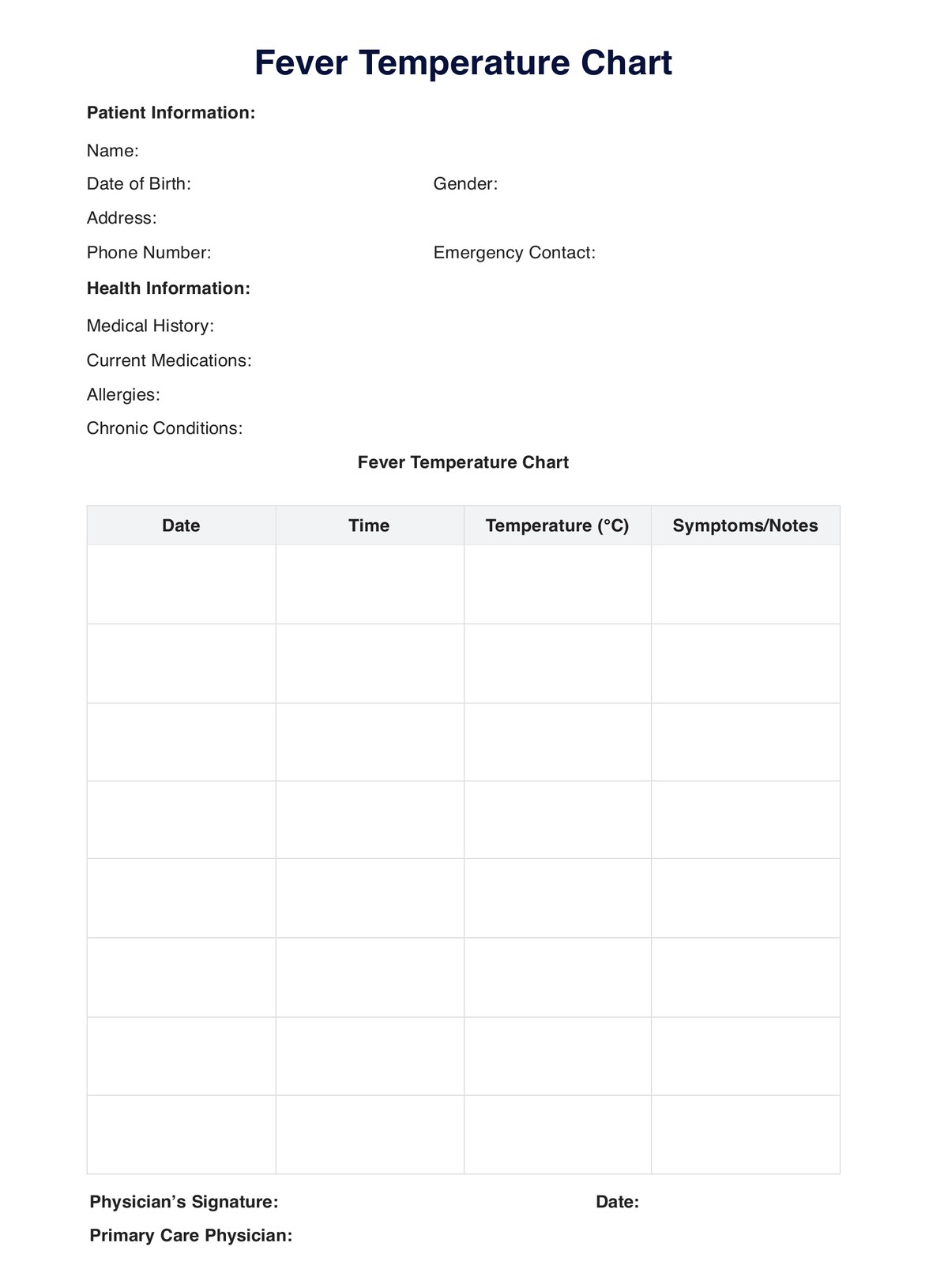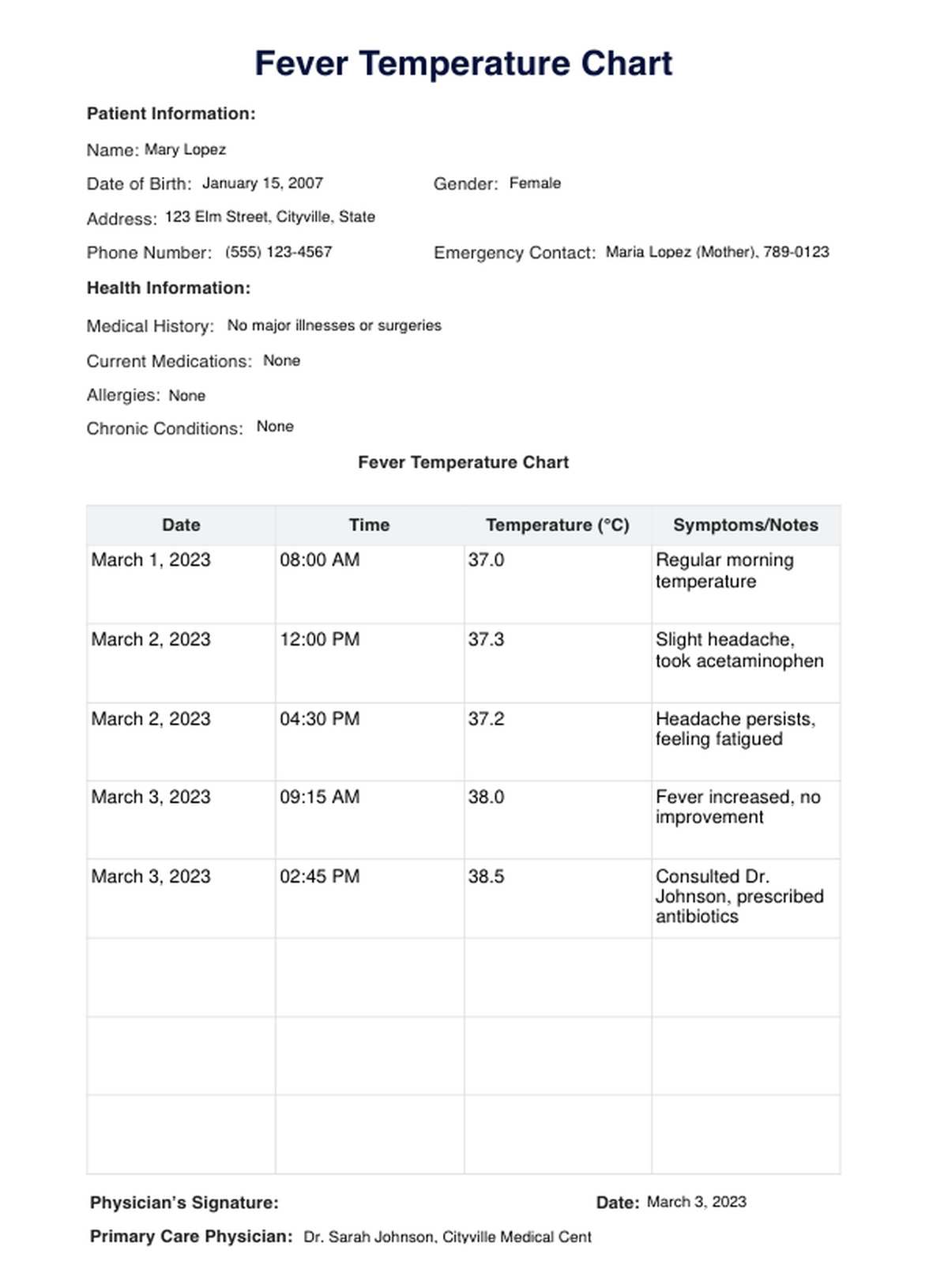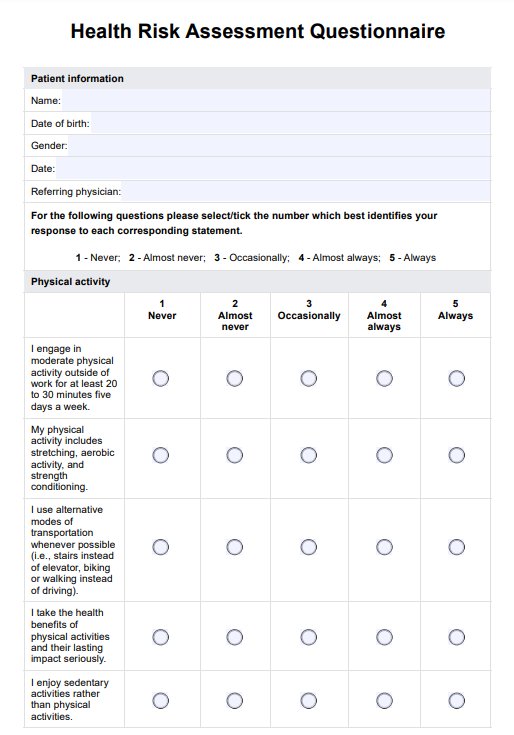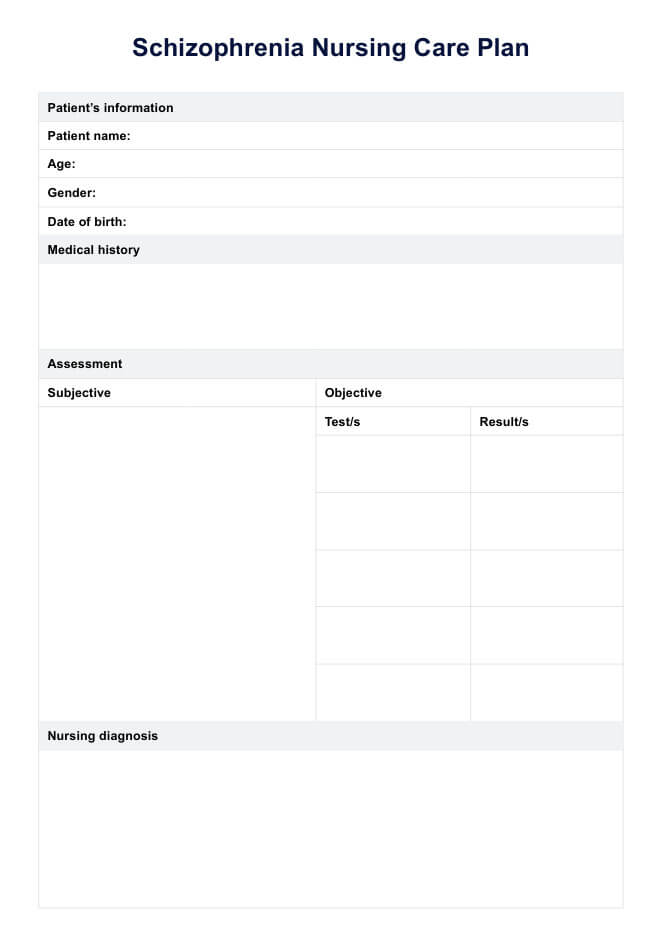Fever Temperature Chart
Track your health with precision using our Fever Temperature Chart. Monitor temperature symptoms and get medical help for optimal care.


What is a Fever Temperature Chart?
Imagine a scenario where you or a loved one battles a fever, and the doctor asks about temperature progression and associated symptoms. In these moments of uncertainty, a well-organized tool, such as the Fever Temperature Chart, becomes helpful.
A fever temperature chart records and tracks body temperature swings during illness or health issues. This template includes areas for patient information, health history, and a complete temperature log. For instance, a 16-year-old student could effortlessly track her fever, jotting down temperatures and noting symptoms and the effectiveness of medications.
Users can enter data quickly, noting the date, time, and temperature. The space for symptoms ensures a comprehensive grasp of the condition, allowing for better-informed interactions with healthcare specialists. This organized method helps you and your healthcare practitioner find patterns, evaluate the effectiveness of interventions, and make well-informed decisions regarding your care.
Fever Temperature Chart Template
Fever Temperature Chart Example
What is a normal body temperature?
A normal body temperature is a vital indicator of one's health. However, it can vary depending on the age group and the measurement method.
The average body temperature is 36.4°C to 37.2°C, or 97.5°F to 98.9°F. Generally, it is greater in the evening and lower in the morning. Most medical professionals define a fever as 100.4°F (38°C) or above (John Hopkins Medicine, 2019).
Below are the different normal temperature ranges for children based on the method according to Paediatrics & Child Health (2000):
- Rectum: 36.6°C to 38°C (97.9°F to 100.4°F)
- Mouth: 35.5°C to 37.5°C (95.9°F to 99.5°F)
- Armpit: 34.7°C to 37.3°C (94.5°F to 99.1°F)
- Ear: 35.8°C to 38°C (96.4°F to 100.4°F)
How does it work?
Understanding the functionality of the Printable Fever Temperature Chart is essential for effective health monitoring. Follow these steps to navigate the worksheet and ensure accurate recording:
Step 1: Download the template
Begin by downloading the Printable Fever Temperature Chart template. Save it to your preferred device for easy access.
Step 2: Patient information
Fill in the required fields with accurate patient information, including name, date of birth, gender, address, phone number, and emergency contact details.
Step 3: Health information
Provide details about the patient's medical history, current medications, allergies, chronic conditions, and the name of their primary care physician.
Step 4: Temperature recording
Record body temperatures by inserting the date, time, and the corresponding temperature in degrees Celsius. Be consistent in your recording times for accurate tracking.
Step 5: Symptoms and notes
In the designated space, describe any symptoms experienced by the patient, such as body heat. Include information about medications taken, their effectiveness, and any other relevant notes.
Step 6: Consistency in recording
Maintain consistency in recording temperatures regularly, especially during illness or health changes. This helps identify patterns and provides a comprehensive overview of the patient's health.
Step 7: Emergencies
If a significant temperature spike or worsening symptoms, such as a persistent sore throat or stiff neck, occur, seek professional medical advice immediately.
Step 8: Consult with healthcare provider
During medical appointments, share the completed chart with the healthcare provider. This enables a detailed discussion, aiding in identifying patterns, assessing interventions, and making well-informed decisions about the patient's care.
Remember, while the Printable Fever Temperature Chart is useful, it is not a substitute for professional medical help. If unsure or in case of severe symptoms, seek medical help promptly.
Causes of fevers
Understanding how fever occurs is crucial for both patients and healthcare providers. Here are vital points to shed light on the various factors contributing to elevated body temperatures:
- Infections: Infections can come as viral or bacterial infections. Viral infections like common colds and influenza can trigger a fever. The body's immune response to these viruses leads to an elevation in temperature. Bacterial infections, such as urinary tract infections or pneumonia, can cause fevers as the immune system combats the invading bacteria.
- Underlying cause: Fevers may be a symptom of underlying health conditions like autoimmune disorders or inflammatory diseases. These conditions lead to an increased body temperature.
- Medications: Some medications can cause fevers as a side effect. It's crucial to be aware of this possibility and consult with healthcare providers if experiencing unexplained temperature elevations while on medication.
- Heat-related illnesses: Exposure to extreme heat or engaging in strenuous physical activities in hot conditions can lead to heat-related ailments, causing the body temperature to rise.
- Dehydration: Insufficient fluid intake can result in dehydration, leading to a fever. Individuals experiencing symptoms such as dark urine, dry mouth, or dizziness should seek medical attention promptly. Thus, it is essential to stay hydrated.
- Inflammatory conditions: Conditions characterized by inflammation may be associated with recurrent or persistent fevers.
- Respiratory issues: Respiratory infections or difficulties, including pneumonia or bronchitis, can result in fevers. If accompanied by difficulty breathing, prompt medical attention is essential.
The duration of a fever may vary depending on the cause. Some fever lasts 3-4 days if the cause is a viral infection. Always remember to seek medical care if you have a high fever.
Which method should I use?
The best method for measuring body temperature is determined by characteristics such as age, comfort, and accuracy.
Aside from using an oral thermometer, there are other methods of getting one's body temperature. Each method has advantages and disadvantages, and carefully following the manufacturer's instructions is critical.
Oral temperature taking
Oral temperature measurement is a standard and convenient method for adults and older children. Place the thermometer under the tongue, ensuring it makes contact with the sublingual vessels. This approach is non-invasive, rapid, and appropriate for routine temperature readings.
Rectal temperature measurement
Taking rectal temperatures is the most accurate method for babies younger than three months old. A precise measurement is achieved by gently inserting the rectal thermometer about an inch into the rectum and using a bit of petroleum jelly or water-based lubricant for smooth insertion.
While slightly invasive, this approach provides a reliable measurement of core body temperature and is recommended for accuracy in certain age groups.
Ear temperature measurement
Measuring temperature through the ear is fast and easy, especially for fever in children. Pulling the earlobe back and inserting the thermometer tightly enables an accurate reading. However, it is essential to note that various circumstances can alter ear temperatures, and consistency in technique is required for valid comparisons.
Axillary temperature measurement
The axillary or armpit procedure is less invasive, making it ideal for people of all ages and especially suitable for newborns and toddlers. However, it is widely considered less precise than oral or rectal measurements.
Carefully place the thermometer in an adult or child's armpit to use the axillary method effectively, ensuring optimal skin contact. Instruct the individual to keep their arm close to their body during the measurement for an accurate reading
Temperature-taking tips
Ensuring accurate temperature measurement is crucial for assessing health. Here are some helpful tips to get you started:
- Choose a reliable thermometer: Select a consistent thermometer for an accurate temperature reading over time. A digital thermometer monitors temperature using electronic sensors, offering quick and precise readings without the possible risks associated with mercury. On the other hand, a mercury thermometer relies on the expansion of mercury to show temperature, posing a risk of mercury exposure if the device breaks.
- Maintain cleanliness: Ensure the thermometer is clean and disinfected before each use.
- Correct positioning: Position the tip of the thermometer correctly for accurate body temperature measurements.
- Wait for the beep: A digital thermometer is primarily used to ensure accurate readings.
- Consistency is key: Be consistent to track changes effectively, whether oral or rectal temperature taking or in the ear.
- Post-use cleaning: After each use, ensure a clean probe tip with rubbing alcohol, soap, and water to prevent cross-contamination.
Treating fever in a child
Addressing a child's fever can be unpleasant, but you can provide comfort and support with simple actions.
- Use a pediatrician-recommended medication: When dealing with a low-grade fever in a child, consider giving them a pain reliever to alleviate any discomfort. To ensure safe administration, always carefully follow the dose directions.
- Other symptoms to watch: Watch for any other symptoms accompanying the fever. If the fever persists, spikes, or is accompanied by concerning symptoms, consult with a healthcare professional to ensure proper guidance.
- Allow the fever to run its course: Most fevers are the body's natural defense against infection. In many circumstances, things resolve themselves. Maintain your child's comfort and focus on their recovery.
- Keep your child hydrated: Encourage them to drink water, clear broths, or electrolyte solutions. Hydration is vital for the body's immunological response and overall health.
- Dress in lightweight clothing: Avoid overheating by dressing your child in light clothing. This assists in regulating their body temperature and providing a pleasant environment for healing.
- Maintain a comfortably cool room: Make sure that the room in which your child is sleeping is comfortably cool. This contributes to creating a favorable environment for recovery and can assist in alleviating discomfort.
- Seek professional help when needed: If you have concerns about your child's fever, don't hesitate to contact your healthcare practitioner. Their knowledge and experience can provide tailored advice based on your child's needs.
References
Fever chart guide - When to go to the ER | CHOC - When to call a pediatrician & how to break a Child's fever. (2023, December 5). CHOC - Children's health hub. https://health.choc.org/guide/fevers/
How to take a child's temperature. (2000). Paediatrics & Child Health, 5(5), 277-278. https://doi.org/10.1093/pch/5.5.277
Johns Hopkins Medicine. (2019, November 19). Fever. https://www.hopkinsmedicine.org/health/conditions-and-diseases/fever
Commonly asked questions
A Fever Temperature Chart is typically utilized by individuals, caregivers, or healthcare professionals to reference and monitor normal temperatures, aiding in assessing fever or potential health concerns.
Lightweight clothing will help regulate your child's temperature and allow the body to release heat efficiently. A light blanket can also be beneficial as it helps provide comfort and prevent chills accompanying fever.
A fever is part of the body's defense mechanism. It raises the normal temperature, creating an environment less favorable for the growth of pathogens. Moreover, it stimulates the immune system to work more efficiently.















































































































